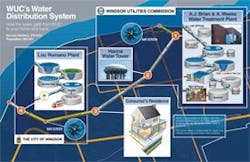For example, Windsor Utilities Commission recently replaced its aging supervisory control and data acquisition (SCADA) system and built in greater redundancy. It also combined these improvements with a second project to upgrade medium- and low-voltage electric switchgear on high- and low-lift pumps at its Detroit River intakes, reservoir booster station, pumping stations and main campus.
However, WUC's innovations encompass more than ozonation and quality management, and its water treatment plant is one of the most advanced in Canada, according to John Stuart, WUC's chief operating officer, his team and their partners at Rockwell Automation.
Consistent Water Needs Data
In early 2010, Stuart and his colleagues recognized that their process controls were reaching the end of their lifecycle and needed upgrading. Rather than waiting for a problem to occur, they sought a solution that would not only bolster the system's data tracking and tracing capabilities, but also reduce the risk that a single-source failure could halt their operations. This meant WUC needed a fully redundant SCADA system with intelligent motor control and networking to improve system diagnostics.
"We don't have a lot of water storage in our distribution system, so we depend on our high-lift pumps," explains Stuart. "If there's any impact on the system, we have just 10 to 15 minutes to go to backup power. So we needed to get away from that potential single point of failure by changing our system architecture, splitting our electrical feed, and adding redundant I/O cards and processors."
Presently, WUC's treatment and distribution system has 2600 discrete I/O points and 900 analog I/O points monitoring the pumps and other equipment's starts, stops, flows, voltages, currents, alarms and other data points. "If the plant had kept its original control system and lost an I/O card, such as the one running the dosing pumps, then the control system would fail to add chemicals to the water, which would have compromised the water quality," adds Stuart. "In a redundant system, two processors and associated I/O cards would have to stop working for such a failure to occur."
Besides improving its tracking, tracing and redundancy, WUC wanted a system that could address three key areas:
- Historical data collection. With its old SCADA system, WUC manually recorded data every hour and risked human error. The new system needed to provide on-the-spot report creation of historical production data.
- Knowledge transfer. Many of the plant's operators were nearing retirement. WUC wanted to retain their knowledge by distilling it into an automated process.
- Employee flexibility. Stuart's team wanted to invest in a wireless platform that would allow one operator to use a handheld, portable tablet to control the system. This would also give WUC staffing flexibility, so it could rely on one operator per shift, rather than two.
New Controls Aid Information Access
Because of their longstanding collaboration, WUC again enlisted Rockwell Automation to help keep its facility on the leading edge of the water utility sector. The supplier's Systems and Solutions Business (SSB) team provided project management services that were instrumental in ensuring the correct hardware, software and overall SCADA system suited WUC's needs.
The two organizations also teamed up with system integrator Onyx Engineering Ltd. and consultant Insyght Systems to upgrade WUC's SCADA system, and help it implement wireless tablets for plant-wide control. To address the outdated controllers, Onyx installed nine Allen-Bradley ControlLogix programmable automation controllers (PACs)—eight with redundant powers supplies and one non-redundant. The SSB team helped design the control panels and supervised their installation. The PACs are integrated to help the utility's operators access plant-wide production information with real-time visibility of water quality, as well as trending loads, levels, clarity and alarms—ultimately enabling better plant management.
Figure 2. Upgrading the SCADA system in WUC's control room and pumping stations included adding ControlLogix PACs and FactoryTalk VantagePoint software, which provides visibility into historical production data via role-appropriate, web-based reports and desktop dashboards.
To improve WUC's data tracking, tracing and reporting capabilities, Onyx installed Rockwell's FactoryTalk VantagePoint software, which delivers unified access to virtually all plant information sources (Figure 2). By tapping into data gathered by FactoryTalk Historian software, FactoryTalk VantagePoint provides visibility into historical production data by putting the information into context via web-based reports. These reports provide role-appropriate visualization of high-level desktop dashboards. Prompt reporting capabilities are helping WUC stay ahead of regulations, and allowing real-time changes to plant processes to avoid downtime, fines or worse.To further improve operations, Onyx and Rockwell integrated more information software. For instance, FactoryTalk Asset Centre change-management software enhances security through a set of asset-centric tools, which document and record all changes made to production on a role- and password-based system. FactoryTalk View Supervisory Edition (SE) HMI software supports distributed-server application, allowing maximum control over plant information. And, all programming was standardized to ease troubleshooting and future expansion of the control system.
"We've also got an aging workforce," adds Stuart. "Within 10 years, we're likely to lose all of our operations guys and a lot of our institutional knowledge. Also, there was little or no redundancy on the software we had, so we would have been out of luck if there was a failure," adds Stuart. "So our operators customized the FactoryTalk View SE software to match the unique needs of our operations. Being able to capture our operators' knowledge in this new SCADA system was invaluable."
In addition, WUC replaced conduits and wires from each I/O with ControlNet networks to help reduce wiring and installation costs, increase reliability and enable point-to-point management and troubleshooting. ControlNet is also used to transmit electrical information, bus voltage, motor data and network security to operators using the Common Industrial Protocol (CIP).
Allen-Bradley Centerline low-voltage motor control centers (MCCs) provide the controllers with soft starting and stopping of the continuously run motors, and Allen-Bradley PowerFlex AC drives provide the variable-speed motors with energy savings on pump loads. Allen-Bradley IntelliCenter software connects the MCCs with the rest of the plant, providing real-time diagnostics and MCC documentation to help maximize MCC and related equipment performance. Medium-voltage soft starters were installed in the synchronous and non-synchronous motors, and medium-voltage PowerFlex AC drives replaced the step-up/step-down drives.
Besides providing the products necessary for a plantwide control system, Rockwell Automation also supported WUC with other services. Through comprehensive network validation, Rockwell's engineers verified the installation and operation of WUC's new network. This ensured that the system was consistent with current functional requirements and that WUC could hit the ground running after migrating to the new control system. They also provided onsite training to WUC's operators.
With a robust SCADA system in place, WUC was able to achieve its ultimate goal of moving to a platform uses wireless, tablet-based controls. Also, Stratix industrial Ethernet switches provide secure integration with the enterprise network, so employees can confidently use the wireless devices without fear of outsiders hacking the system. Operators are now free to make rounds and take samples anywhere in the plant without the risk of missing an alarm because they were not within earshot of the control room.
Smarter SCADA Means Safer Water
The new SCADA system at WUC was commissioned in early 2010, and completed under its $3.8 million budget in January 2011. WUC became the first water provider in Ontario to use wireless tablets for plant control, and in August 2011, the plant transitioned from two operators per shift to one. The new system also eliminated the risk of single-source failure, and has helped reduce the risk of reporting errors by automatically tracking and tracing plant data.
Improved real-time control helps reduce downtime since operators can now proactively fix problems. When an issue does occur, the tablet allows operators to work directly with maintenance professionals at the source of the problem, rather than communicating commands over a phone or radio from the control room.
In the future, WUC plans to integrate its laboratory information management system onto the FactoryTalk VantagePoint software, and also use the new control system's power monitoring capability to check separate electrical feeds, determine how much power is used for pumping at different flow rates, and improve pumping efficiency. The ability to determine the most efficient flow rate will give plant management and staff the ability to optimize the backwash and chemical process dosing by 2013.








